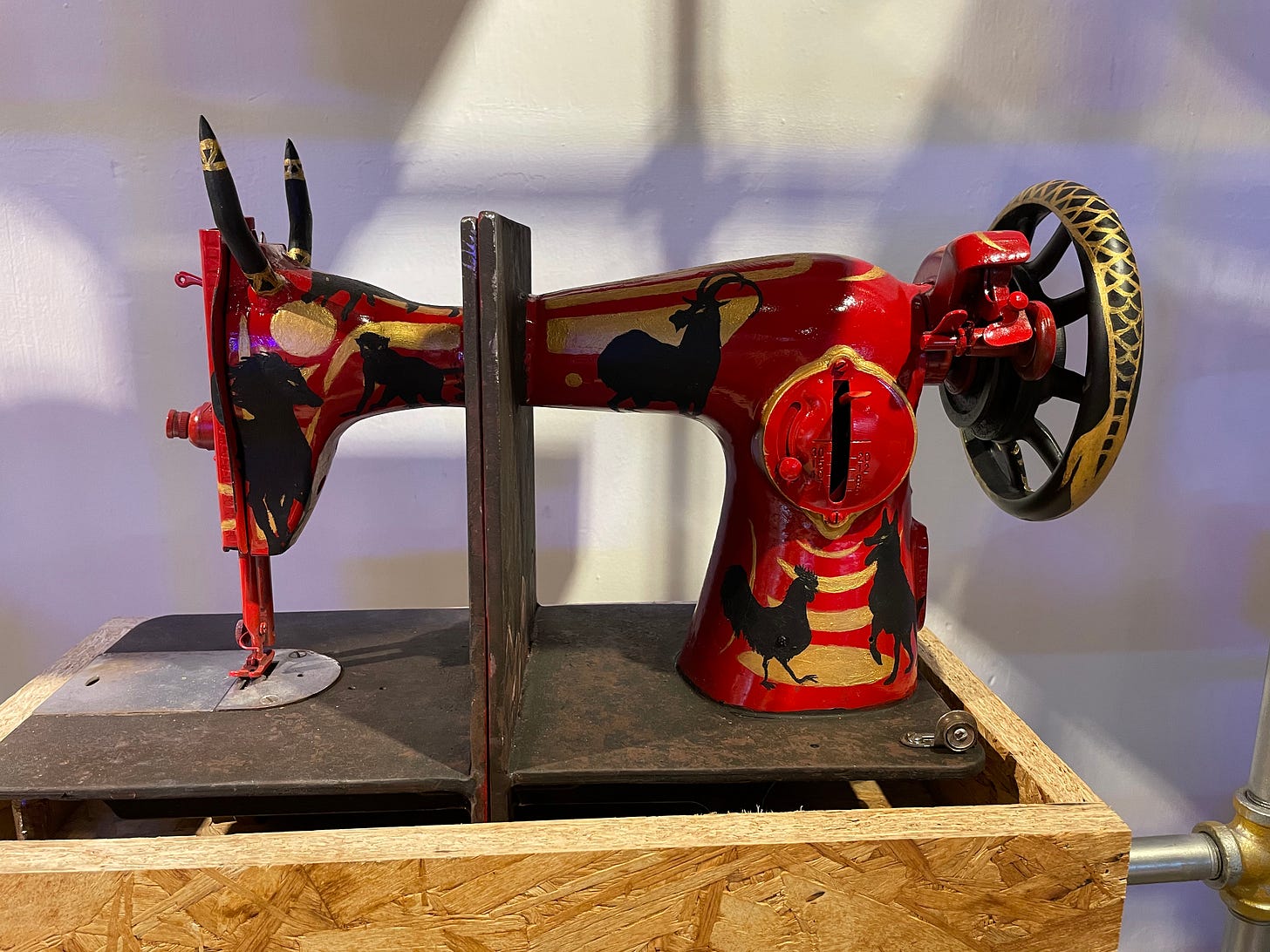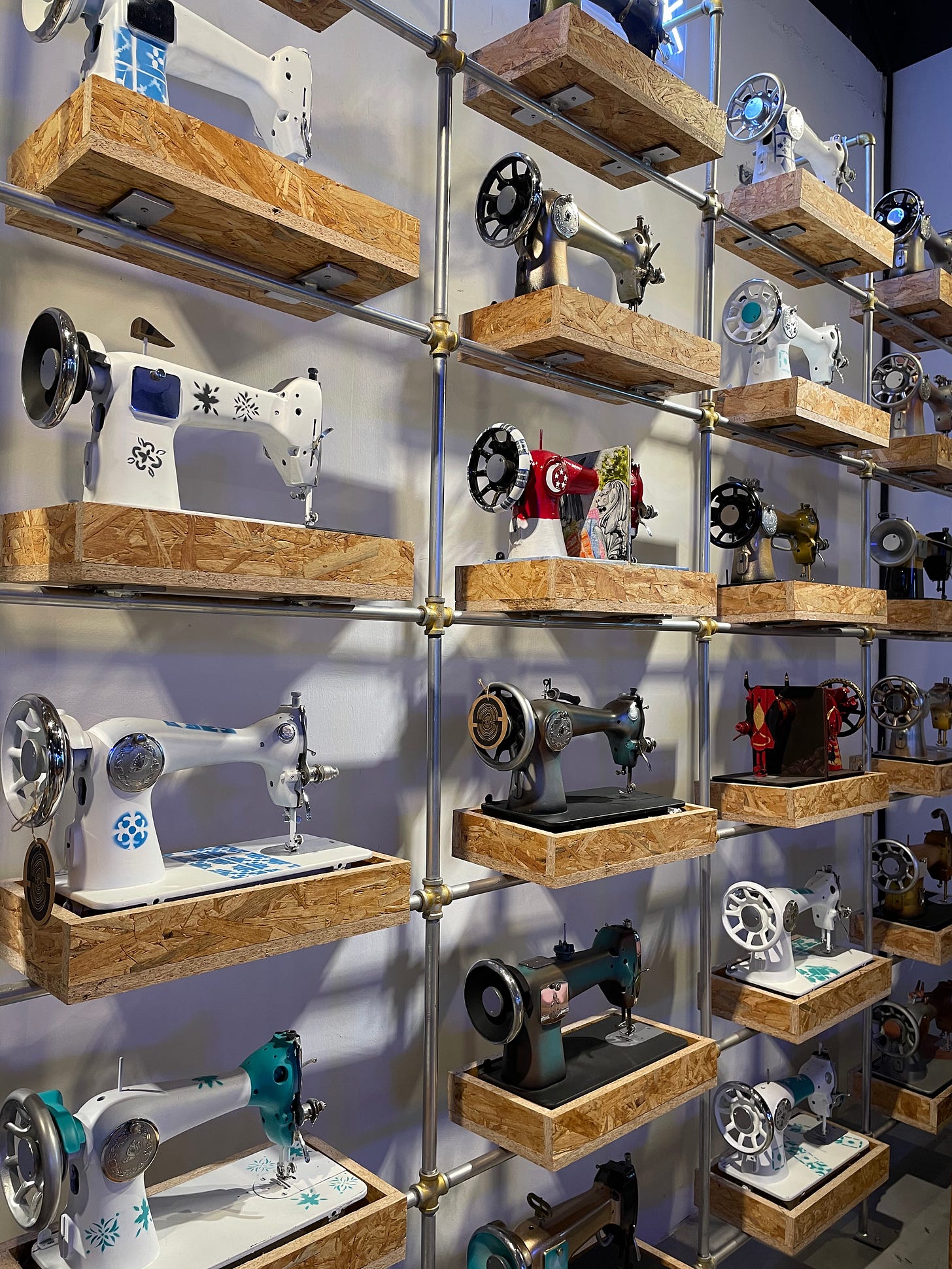NOSTALGIA AND THE STORY OF A SEWING MACHINE
This is the story of how an object that embodies the collective nostalgia of people from Singapore has such resonance in my own life.
In one corner of a bedroom in my late father’s apartment in India’s Chennai rests a handsome black Singer sewing machine bought in 1957 in Pakistan. We haven’t given it away even though it hasn’t been used in at least a couple of decades.
Our mother has been deceased for over fifteen years but we cling to the machine in spite of it. This summer it will be seven years after our father’s passing but there is comfort in knowing that the sewing machine remains in the corner of our parents’ apartment. My only sibling, an elder sister, is a clean-up queen, a vanquisher of clutter. Yet I can see that she wants to hold on to our Singer because it evokes memories of happy times in a small bungalow in India. It is a family heirloom, a reminder of many years of halcyon days under a father’s meagre salary.
I didn’t realize just how a sewing machine might have had the same relevance and meaning to countless families in Singapore. Since my arrival here, I’ve been surprised by the number of times I’ve encountered it. It’s a relic that evokes a collective past for vast swathes of this country that experienced severe scarcity of basic necessities and food rations during the Japanese Occupation of Singapore from 1942 to 1945 and in the years that followed.
The late Prime Minister Lee Kuan Yew wrote about how families scrimped and saved during the war years in The Singapore Story: “Textiles were scarce, so we converted fabrics and tablecloth into trousers and shirts.” In “Kampong Spirit” author Josephine Chia recalls how her “mother pedalled furiously on her Singer sewing machine to make new clothes for my siblings and myself.” The whole family wore floral print during some periods because their parents could not buy enough fabric to sew curtains for the house as well as their clothes and hence a previous year’s curtain cloth often got converted to articles of clothing.
At the National Museum of Singapore, visitors can look at a sewing machine with a foot pedal from 1940s that was a gift from Joseph Linus to his wife Grace, both from India’s Kerala. In Singapore the sewing machine is also a testament to the country’s industrial progress when, in the sixties, people in the villages also found work in factories around the island.
The sewing machine is thus a physical embodiment of nostalgia in a country that’s constantly reminding its people to not forget where they came from. How does one evoke the past when the past itself is all but gone—when the mangrove swamps have been chewed up, when the old villages (kampongs) have molted into high-rise buildings, when the oldest railway line is extinct, when the first national library has been sacrificed—in the pressure to upgrade, gentrify and modernize? Singapore is constantly renewing itself—at a pace that the rest of the world cannot even fathom.
I notice, along the same vein, a manic effort at work reminding people to cherish their uniqueness as well as their collective experience in the diverse spirit of Singapore. The country does this overtly through organizations such as the National Museum of Singapore and the Urban Redevelopment Authority (URA) gallery. It conveys it subtly through the murals around town that recall the forgotten ways of life. I also see messages in smaller galleries just about everywhere: The Fullerton Hotel, with the first post office and its historic moments; the Tampines library, with an exhibit on how village life used to be long ago on that land; the Alexandra Hospital grounds and the massacre during World War II; the heritage centers dedicated to Chinese, Malay and Indian communities. The nation tries to write the narrative of what exactly it means to be Singaporean, no matter what kind of ethnic Singaporean someone may be. It’s not easy. When so many different kinds of people call this country home, how must it foster a sense of belonging? How must it steer its people towards oneness while eschewing the force of nationalism that makes people embrace one and reject another?
I see, among the many objects of nostalgia, the story of the sewing machine as the story of everyone’s past. For which of us born after the industrial revolution does not identify with it? At Serangoon Road in Singapore’s Little India enclave, I still see many shops under five-foot walkways where sewing machines await clients who walk in for minor alterations of their garments.
A few weeks ago, I saw how artfully someone had given expression to nostalgia when I walked into an unusual store space in the mall at the Esplanade, Singapore’s renowned theater by the waterfront. A whole wall dedicated to sewing machines drew me to a store called Smoke Signature. The day I met one of its founders, Marcus Wang, I discovered that Smoke was one of those rare spaces giving both form and function to nostalgia, whether it was by means of Zen-inspired stools or bowls, tables fashioned from local wood, retro artwork or sewing machines.
The sewing project at Smoke celebrates a time in Southeast Asia when men were mainly the sole breadwinners of the family and women helped out their families by taking on simple sewing jobs for extra income. The founder told me how Smoke reclaims, recycles, and reinvents old sewing machines to preserve their impact while also telling another story through a new coat of paint.
“The sewing machine signifies advancement, freedom, and handwork. It is a meaningful but often overlooked piece of Singapore heritage. We have two main themes for our sewing machines: Peranakan and Steampunk. Through our Peranakan themed sewing machines, we showcase the story and culture of the Peranakan people and celebrate how Nonya women were well known for their intricate clothing designs in the past. Our steampunk theme captures the age of industrialization in Singapore, a time when machinery took over manual labour.” ~ Smoke Signature
Smoke embodies this Singaporean nostalgia with its thrust on minimalism and conservation using recycled wood, too. A friend who bought a few pieces of furniture here said she had been attracted to the fine workmanship. I too was drawn to the black furniture charred using a Japanese method to extend the life of the wood. Whenever Wang sees a compelling piece of abandoned suar wood, he tries to understand how to express it best. “My inspiration comes from the material itself. I don’t design and start looking for wood. That’s the difference between me and other people. That’s the flow, where the energy comes from.”

Having seen how progress can wipe out old lifestyles, forests and cultures, Wang chooses to work with felled or recycled suar wood (rain tree wood originally introduced into Singapore from Brazil) that’s popular on the island. Every piece of art Wang’s company creates with suar wood—whether it’s a coffee table or a console or an art work—is a conversation piece.
In the same spirit of celebrating locally sourced products, the sewing machines on display are discards bought from home attics around Singapore; they may have made their way into garbage dumps if Wang had not breathed life to them. At Smoke, some sewing machines are made into bookends; a few are whimsical statement pieces; others are working machines. Wang sees value in each machine he buys. “To me it still has beauty in it because I don’t know how it’s going to transform.” And it’s that transformative quality that Wang tries to express through each of his projects, conveying thus an indescribable feeling of something elusive that needed to be captured.

I suppose the notion that something in the past was beautiful and worth preserving—even if it’s not a time or a way of life that we want to cleave to—is a feeling that unites us all. After our father passed away, my sister pulled out a book from a compartment inside our Singer machine, a book from 1966 containing her sewing lessons and paper patterns. In it she had recorded the many steps that she had been taught to make baby clothes, underwear, a sari blouse, a petticoat and more—all of which are now sartorial accoutrements that we pick up in retail stores for cheap.
Even though my sister and I own electric sewing machines in our respective homes, it seems our hearts are still under the press of the old Singer’s footplate. The reasons become more obvious as the years unfurl: With every object we let go from our parents’ home, we know we stand to lose another swatch of family history and our identity.





Loved the article and the pictures Kalpana! I used to enjoy watching my mother's Singer Sewing machine work, when she used it to mend my torn frocks. During my summer holidays, my mother let me us the machine for stitching random stuff. Your article sent me off to those old times!
Every week is a learning Kalpana , after reading your letters . Enjoyed this one thoroughly .